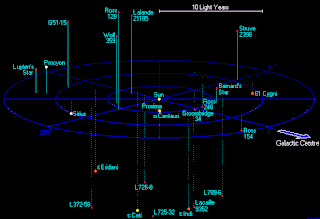
Color or colour is the visual perceptual property deriving from the spectrum of light interacting with the photoreceptor cells of the eyes. Color categories and physical specifications of color are associated with objects or materials based on their physical properties such as light absorption, reflection, or emission spectra. By defining a color space, colors can be identified numerically by their coordinates.

Infrared (IR), sometimes called infrared light, is electromagnetic radiation (EMR) with wavelengths longer than those of visible light. It is therefore invisible to the human eye. IR is generally understood to encompass wavelengths from around 1 millimeter (300 GHz) to the nominal red edge of the visible spectrum, around 700 nanometers (430 THz). Longer IR wavelengths are sometimes included as part of the terahertz radiation range. Almost all black-body radiation from objects near room temperature is at infrared wavelengths. As a form of electromagnetic radiation, IR propagates energy and momentum, with properties corresponding to both those of a wave and of a particle, the photon.

Light or visible light is electromagnetic radiation within the portion of the electromagnetic spectrum that is perceived by the human eye. Visible light is usually defined as having wavelengths in the range of 400–700 nanometres (nm), corresponding to frequencies of 750–420 terahertz, between the infrared and the ultraviolet.

A light-emitting diode (LED) is a semiconductor light source that emits light when current flows through it. Electrons in the semiconductor recombine with electron holes, releasing energy in the form of photons. The color of the light is determined by the energy required for electrons to cross the band gap of the semiconductor. White light is obtained by using multiple semiconductors or a layer of light-emitting phosphor on the semiconductor device.

The speed of light in vacuum, commonly denoted c, is a universal physical constant that is important in many areas of physics. The speed of light c is exactly equal to 299792458 metres per second. According to the special theory of relativity, c is the upper limit for the speed at which conventional matter or energy, and thus any signal carrying information, can travel through space.

A camera is an optical instrument that captures a visual image. At a basic level, cameras consist of sealed boxes, with a small hole that allows light through to capture an image on a light-sensitive surface. Cameras have various mechanisms to control how the light falls onto the light-sensitive surface. Lenses focus the light entering the camera. The aperture can be narrowed or widened. A shutter mechanism determines the amount of time the photosensitive surface is exposed to light.

A rainbow is a meteorological phenomenon that is caused by reflection, refraction and dispersion of light in water droplets resulting in a spectrum of light appearing in the sky. It takes the form of a multicoloured circular arc. Rainbows caused by sunlight always appear in the section of sky directly opposite the Sun.

A light-year, alternatively spelled lightyear, is a large unit of length used to express astronomical distances and is equivalent to about 9.46 trillion kilometers (9.46×1012 km), or 5.88 trillion miles (5.88×1012 mi). As defined by the International Astronomical Union (IAU), a light-year is the distance that light travels in a vacuum in one Julian year (365.25 days). Because it includes the time-measurement word "year", the term light-year is sometimes misinterpreted as a unit of time.

The Stenomatinae are a subfamily of small moths in the family Depressariidae.
Promenesta is a moth genus of the family Depressariidae. It is endemic to South America.
Promenesta autampyx is a moth in the family Depressariidae. It was described by Edward Meyrick in 1925. It is found in Peru, Paraguay and Brazil.
Promenesta callichlora is a moth in the family Depressariidae. It was described by Edward Meyrick in 1915. It is found in Guyana.
Promenesta capnocoma is a moth in the family Depressariidae. It was described by Edward Meyrick in 1931. It is found in Brazil.
Promenesta chrysampyx is a moth in the family Depressariidae. It was described by Edward Meyrick in 1915. It is found in Guyana, Brazil (Amazonas) and Peru.
Promenesta haplodoxa is a moth in the family Depressariidae. It was described by Edward Meyrick in 1925. It is found in Brazil (Amazonas).
Promenesta isotrocha is a moth in the family Depressariidae. It was described by Edward Meyrick in 1918. It is found in Argentina.
Promenesta leucomias is a moth in the family Depressariidae. It was described by Edward Meyrick in 1925. It is found in Pará, Brazil.
Promenesta triacmopa is a moth in the family Depressariidae. It was described by Edward Meyrick in 1931. It is found in Paraguay.
Promenesta marginella is a moth in the family Depressariidae. It was described by August Busck in 1914. It is found in Panama.
Promenesta solella is a moth in the family Depressariidae. It was described by Francis Walker in 1864. It is found in Amazonas, Brazil.








